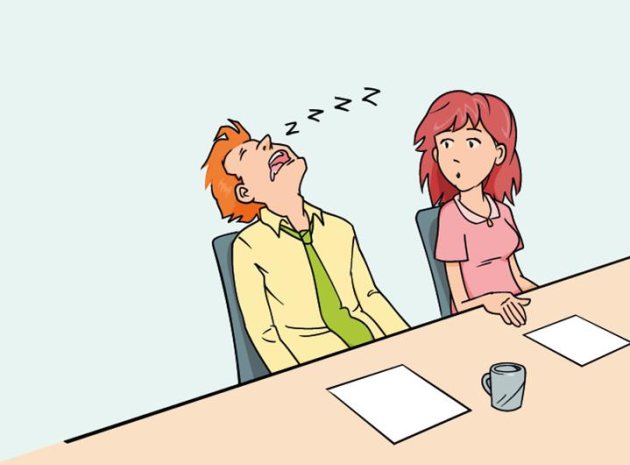What are your staff meetings like? Do you eagerly anticipate them as exciting forums for a stimulating exchange of professional views? Or do you trudge along wearily because they are a time-consuming black hole of pointlessness sucking the very joy out of life itself ?
Do your meetings take place round a conference table and with a brisk, efficient, business-like atmosphere? Or are exhausted staff slumped in the stained armchairs where the drone of the head is punctuated only by the parade of teachers shuffling from kettle to biscuit tin?
An NASBM study of wastefulness found that, even in successful schools, time spent on meetings was mostly wasted time. Its advice was not to keep going to meetings every week to discuss things, but instead to focus on what you want to achieve, and devise actions to let you achieve it. There’s the difference. Action counts. And most meetings are merely appearing to take action while actually avoiding doing so.
Detailed research (a quick Google) has revealed that meetings are regarded as (potentially) excellent vehicles to pool and develop ideas, solve problems, make decisions and provide a sense of direction. But realistically they are also a sure-fire way to confuse, brown off, bore and demotivate, so it’s important to them right. Which, I should add, includes not calling them in the first place.
Hard times
Meetings are sometimes useful, but seldom vital. The third law of education dynamics is ‘Bulls**t (B) expands in direct association (a) with the lack (l) of limits (L) in meetings being sustained (s) longer than their useful (u) purpose (p) – also known as ‘BalLsup’. Having a fixed start and end time gives a meeting certainty, and prevents a ballsup coming into play. Stick to a maximum of 60 minutes.
At the end of the working day it’s motivating for staff to meet as a team, but people are tired. If the business of the meeting is concluded early, don’t pad it out – as some heads do in a bizarre attempt to stamp their authority on the staff. Close the meeting. Likewise, if two minutes before the meeting ends a teacher says, ‘I’ve just grasped the true meaning of life, but it’ll take three minutes to explain,’ cut him off. Staff are free to learn of the meaning of life in their own time, if they wish; the formal meeting never ends later than 4.30.
Separate ‘any other business’ and information sharing from the main staff meeting with a morning briefing. Another meeting, yes, but it gets all the bitty stuff out of the way in 10 minutes max – timetable issues, caretaker’s complaints, the staff ‘do’ – leaving the one-hour staff meeting devoted purely to curriculum, school improvement and professional development.
If there is nothing to discuss or decide, which, face it, sometimes there just isn’t, cancel the meeting but give the time a purpose – call it additional PPA time, for instance, or staff wellbeing.
What are the alternatives to formal meetings? Sticking a fork in your eyes whilst sinking in quicksand can offer a similar experience, but more practically, an email, text or note on the staffroom board can communicate quickly and effectively.
Where meetings go wrong
1. Calling one in the first place.
2. Having no clear idea of what a successful outcome might be.
3. Allowing the meeting to drift long past the point of usefulness – this is usually after the first 10 minutes.
4. Allowing it to be hijacked by whingers and begrudgers who’ve seen every educational innovation several times in their career (and didn’t like them first time round).
5. Conducting it in a way that allows staff to relax – this is where the idea of the stand-up meeting comes from. Stand up meetings are legendarily short and to the point because people can’t relax into them. By that token, standing up on hot coals would be better still.
6. Don’t buy into the assertion that staff need to have ‘ownership’ of all decisions. Often, staff want the highly paid SLT member – you – to decide what needs to be done, and to bloody well do it! If staff need ‘ownership’ of the decision, give them a photocopy of it to keep.
Where meetings go right
1. There is no other alternative.
2. Start and finish promptly.
3. They focus on sharing best practice, notably in relation to school improvement plan priorities. Leave the meeting with a next step – how might I use this idea this week?
4. Any reading is circulated at least 24 hours in advance of the meeting.
5. The Chair ensures everybody has a say but nobody dominates. This means occasional brutality in cutting someone off, as well as drawing in reluctant contributors: “Say something you taciturn bastard or no one leaves till the caretaker kicks us out,” will be less effective than a simple, “What’s your view?”
6. Host meetings in different classrooms so they can be used to share, in a practical way, classroom practice.
7. All staff take the opportunity to lead a staff meeting. This develops them, shares the load and should ensure diverse opinions (and subjects) are given an airing.
8. Make sure all staff are aware they are welcome at staff and SLT meetings. Few take up the offer but they know they can if they want.
9. There is an official note taker, rotated each meeting (so that everybody suffers in turn). Never, ever make notes yourself. Anything important will be in the official notes of the meeting. If you don’t remember it, chances are it wasn’t worth remembering.
Finally, don’t innovate too much in an attempt to make meetings more interesting. Pity the teacher who attended her first INSET at her new school in a swanky hotel, only to discover that the initial staff meeting was being held in the hot tub. This is education, for goodness’ sake, not a 70s porn movie. Always, always, always hold staff meetings fully clothed.
7 ways to make meetings better
It’s common for meetings to be time-consuming and ineffective, and it takes a concerted effort to break out of this cycle. Rethink how time is used. Focus on what you want to achieve and devise actions to let you achieve those goals.
- Pre-distribute any documentation for the meeting at least 24 hours before to allow attendees to pre-read the content.
- Have an effective chairperson to keep everyone on track yet ensure all who need to are able to contribute.
- Make sure that someone is monitoring the agenda timing to keep everyone strictly on schedule.
- Schedule “any other business” for the start of the meeting and for each item decide whether to include it at the end of the meeting or defer to a subsequent meeting.
- Assign actions to individuals with a target deadline; follow through on actions and timing as part of the meeting to instil an expectation that actions need to be completed on schedule.
- Use smaller working groups, led by the action owner, to research, plan and recommend decisions. The action owner should come to the meeting with a decision-ready plan and aim to present this to the group in under two minutes.
- With less content, consider having stand-up meetings to keep them short.
These ideas are based on the latest research from the National Association of School Business Managers which you can download at tinyurl.com/TPNASBM
About the author
Kevin Harcombe (@kevharcombe) is a Teaching Award winner and headteacher at Redlands Primary School, Fareham. To read more of his articles visit teachwire.net








